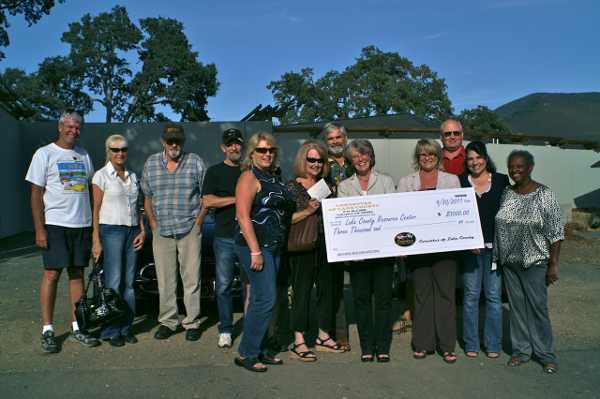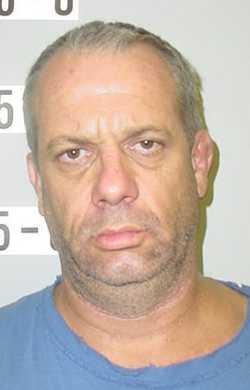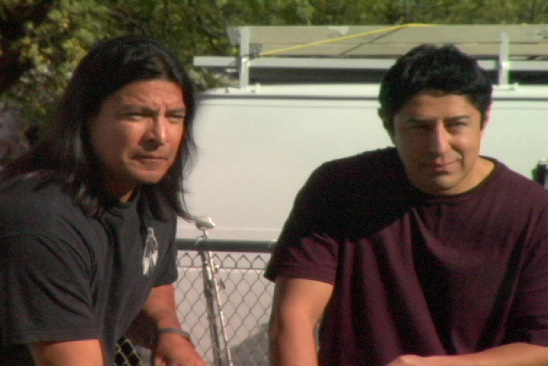
The sweet-tart taste of these freshly-picked Gravenstein apples makes them perfect for applesauce or pies. Photo by Esther Oertel.
The tree was small, with gnarled limbs on which grayish-green patches of lichen had made its home. The apples, though growing plentifully, were small, some the size of large cherries. Someone should have thinned the fruit, but the tree had been neglected.
Apples filled the bowl as I picked them from the tree, a motley crew of misshapen fruit in various sizes, some with patches eaten away by yellow jackets. I didn’t hold out hope for making much from this harvest, especially since many revealed inner rot when I cut and peeled them later in the kitchen.
But I plugged away, bit by bit, till every usable scrap of apple was peeled, cleaned, and tossed in a pot. To my surprise, the yield nearly filled two pots with fruit ready to be cooked into applesauce.
Alchemy occurred with the addition of heat and just a little bit of water. The apples softened into a chunky sauce, to which the smallest touch of brown sugar was added. A light dusting of cinnamon followed.
The result was truly magical. A highly flavored, not-too-sweet, fresh-tasting, soft but chunky sauce had been formed from the humble fruit. My son said it was the best he’d ever tasted and my heart swelled with pride.
It wasn’t me, however, who deserved the credit; it was the pure taste of one of the best cooking apples on the planet, the Gravenstein. If you’ve never made sauce with them or baked them into a pie, it’s well worth seeking them out for your first experience.
This apple variety is native to Denmark, where it was discovered as a chance seedling in 1669. It was introduced to western North America in the early 1800s by Russian sea traders, who planted a tree at their Fort Ross, Calif., settlement.
Renowned botanist and agricultural pioneer Luther Burbank was particularly fond of the sweet-tart Gravenstein apple. Of it he said, “If the Gravenstein could be had throughout the year, no other apple need be grown.”
The U.S. Gravenstein apple crop is concentrated in western Sonoma County, specifically near the town of Sebastopol.
This amazing apple is a difficult commercial crop. They don’t store well, making them available only in season, and short stems and variable ripening times make harvesting and selling difficult.
Sadly, most commercial Gravenstein orchards have disappeared due to suburban sprawl, grape vineyards, and bad economic conditions. Few growers are left.
In 2005, Slow Food USA declared the Sebastopol Gravenstein apple a heritage food and included it in their Ark of Taste, an international catalog of heritage foods in danger of extinction.
I feel grateful whenever I see Gravensteins in a store or on a tree. It’s good to know some still exist, even if in smaller quantities than in the past when they were shipped to World War II troops in the form of dried apples and applesauce.
We are in the midst of apple season, and the Gravenstein is but one of more than 7,500 known cultivars of apples. Most are harvested between August and November.
Apples are divided into three groups: dessert or table apples, which are bred for eating; cooking apples, such as the Gravenstein, which are bred for baking, drying, and making into applesauce; and cider apples, which are typically too tart and astringent to eat fresh, but impart a rich flavor to cider.
Lake County is home to a small handful of commercial apple growers. Apples grown by the Seely family of Upper Lake are available now at farmers’ markets, as well as at their farm stand through November.
I spotted a couple of interesting dessert apples at their booth at the Lake County Farmers’ Finest market in Lakeport’s Library Park Wednesday: Ozark Gold, similar to the Golden Delicious, and Prime Red, a cross of Jonathan and Worchester apples. Both looked tempting, with bright colors and firm textures.
Farmer Haji Warf of Upper Lake’s Kalikai Farms offered netted bundles of petite green apples at the market. These old-fashioned apples are crisp, with a surprisingly sweet taste belied by the color of the skin.

Ozark Gold and Prime Red apples were for sale at the Seely Family Farms booth at the Lake County Farmers' Finest market in Lakeport, Calif. on Wednesday, September 28, 2011. This market is now over for the season, but Seely apples will be available at the Saturday morning farmers' market held at Steele Winery in Kelseyville, Calif. through October. Photo by Esther Oertel.
The Library Park market has run its course as of last Wednesday, but the one at Steele Wines in Kelseyville on Saturday mornings will be in full swing through the end of this month. Both growers will likely continue to be there with apples in tow.
Apples are members of the large rose family. Wild ancestors of apples known today still grow in remote mountainous regions of central Asia, such as in southern Kazakhstan and surrounding countries.
Almaty, Kazakhstan’s capital and largest city, derives its name from the Kazak word for apple, “alma.”
I particularly enjoy apples in savory applications. My mother has developed a new favorite dish inspired by Alice Waters. Made with sweet potatoes, apples, and onions sautéed together in a skillet until the apples become caramelized, it’s absolutely delicious as an unusual side dish.
Another favorite of mine is sautéed apples and purple cabbage flavored with fennel or sage. White wine vinegar and currants or raisins add acidity and sweetness, respectively, for a balanced dish. As you can imagine, this is a nice accompaniment to pork or sausages.
Apples may be cored and stuffed with a bit of butter, brown sugar, and cinnamon and then baked until soft and sweet for a dessert reminiscent of apple pie, though a bit healthier. This was something that was often served in my otherwise dessert deprived childhood (and that’s not a complaint).
“An apple a day keeps the doctor away” is a phrase that’s said to have been coined in 19th century Wales, and it’s proven to be true to some extent. Research indicates that apples contribute to good health by reducing the risk of colon, prostrate and lung cancer.
They may also help with heart disease, weight loss, and controlling cholesterol. Compared to many other fruits and veggies, apples are relatively low in Vitamin C; however, they’re rich in other antioxidant compounds.
If an apple a day doesn’t keep the doctor away, it will at least delay him or her.
There are so many wonderful ways to use apples: in a rustic tart, for example, or baked into bread or added to butternut squash soup.
Today I’ve chosen something a little different to share, a salad by British Chef Jamie Oliver that features apples along with their elegant and recently-celebrated cousin, the pear.
The salad utilizes endive as its green. Endive, also known as chicory, has a bitter taste. It’s not sold in every supermarket, but with a bit of research it can be found. Relatives such as radicchio, escarole, or frisee (curly endive), impart a similar bitter taste and may be substituted. In a pinch, a mixture of Romaine lettuce and arugula will do.
While Oliver doesn’t include this in his recipe, I think a sprinkling of toasted Lake County walnuts would be a fantastic addition.
Enjoy!
Sweet pear and apple salad with bitter endive and a creamy blue cheese dressing
4 heads of endive (a mixture of red and white, if possible)
2 eating apples
2 pears
A handful of soft herbs (chervil, tarragon, parsley – use only one, or a mixture), torn or chopped
For the dressing:
2 ounces strong blue cheese
¼ cup crème fraiche (or plain yogurt or sour cream)
5 tablespoons extra virgin olive oil, plus a little extra for drizzling
4 tablespoons cider vinegar
6 tablespoons water
Separate the endive leaves, wash and spin dry.
Core apples and slice them into matchsticks.
Core pears and slice them into eighths. (If under ripe, grill until lightly charred.)
Mix above ingredients in a large bowl, along with most of the herbs. (Reserve some herbs for garnish.)
Add dressing ingredients to a blender and process for about 15 seconds, until smooth.
Plate salad mixture and add blue cheese dressing. Finish with a drizzle of olive oil and herbs for garnish.
Makes four servings.
Recipe by Jamie Oliver and courtesy of Jamie at Home.
Esther Oertel, the “Veggie Girl,” is a culinary coach and educator and is passionate about local produce. Oertel teaches culinary classes at Chic Le Chef in Hidden Valley Lake, Calif., and The Kitchen Gallery in Lakeport, Calif., and gives private cooking lessons. She welcomes your questions and comments; e-mail her at This email address is being protected from spambots. You need JavaScript enabled to view it..
Follow Lake County News on Twitter at http://twitter.com/LakeCoNews, on Tumblr at www.lakeconews.tumblr.com, on Facebook at http://www.facebook.com/pages/Lake-County-News/143156775604?ref=mf and on YouTube at http://www.youtube.com/user/LakeCoNews.

Upper Lake, Calif., farmer Haji Warf displays the petite green apples that grow on Kalikai Farm. Photo by Esther Oertel.

 How to resolve AdBlock issue?
How to resolve AdBlock issue? 














